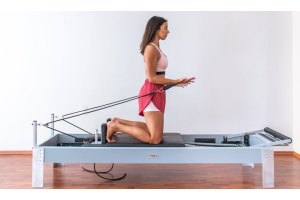Mix up your training to get fitter, stronger and faster
There is a myth that if you want to improve in a certain area, you need to do that particular sport each time you exercise. Yet the popularity of exercises such as CrossFit shows that this isn’t the case. The best cyclists and runners don’t just hit the bicycle or jump on the treadmill, they do a mixture of disciplines. Why? Because to get fitter, stronger and faster, you need to strengthen your whole body.
In order to improve overall fitness, it’s important that you find a general strength and conditioning programme that combines weightlifting (power and Olympic lifting, kettlebell training, medicine balls and dumbbells), gymnastics (squats, press-ups, pull-ups, dips, muscle-ups, sit-ups) and cardio methods (running, rowing, skipping).
The payback
So how will mixing up your training make you fitter? Whilst running for hours will develop your aerobic capability, the stronger athlete will always finish stronger. And not only does strength help your overall speed, but it can also help with injury prevention. Keeping your weekly exercise programme varied, you won’t put too much pressure on certain joints or muscles. Adding in some back squats, deadlifts and kettlebell swings will give structural balance.
Top athletes do additional strength and conditioning to enhance themselves and to improve their performance in their own sport - so why shouldn’t we? Keeping your training varied will also prevent you from getting bored or stuck in a rut.
Benefits of CrossFit
The workout that CrossFit promotes is perpetually changing the mix of aerobic exercise, gymnastics and weightlifting. Those who advocate it believe that it helps increase an individual’s strength while also improving other aspects of their health and fitness including biomechanics, speed, power and endurance. By improving strength in our body, we can better handle more physical stress and increased training volume, helping us to stay free from injury.
For some people, especially those training for a certain sport, if you find that you are staying injury free and improving your times, then you may feel there’s no need to change your training. However, if you find that you are getting injured more often, that your progress has plateaued or you simply want a bit more variety in your training, then a programme such as CrossFit may be worth a try.
Sessions are led by experienced coaches, and usually are taught in a group - making training more sociable and enjoyable.
Common movements with weights
Clean: Barbell is (or dumbbells are) lifted from the ground to a 'rack position' in front of the athlete's neck. Athlete ends in a standing position. In a squat clean the athlete receives the bar in a squatting position and stands to finish the lift. In a power clean, the athlete receives the bar in any position that is above a parallel squat.
Deadlift: Barbell is lifted from the ground, making sure to drive with the legs and glutes, until the athlete reaches an upright standing position.
Kettlebell swing: A kettlebell is swung from between the legs to eye level (Russian) or overhead (American). The kettlebell swing can be used both as an aerobic and anaerobic exercise.
Squat: Barbell is supported on upper back (back squat), in the rack position (front squat), or in the overhead position (overhead squat). From a standing position with a wider-than-shoulder-width stance, the athlete bends the knees until the hips are below the knees, and then stands, keeping the heels on the floor.
Final thoughts
Whether you join a CrossFit exercise class, invest in some equipment at home or join a local gym, it’s important you always follow proper form and get advice from a qualified teacher who guides you in your technique. This isn’t one to experiment on your own!




